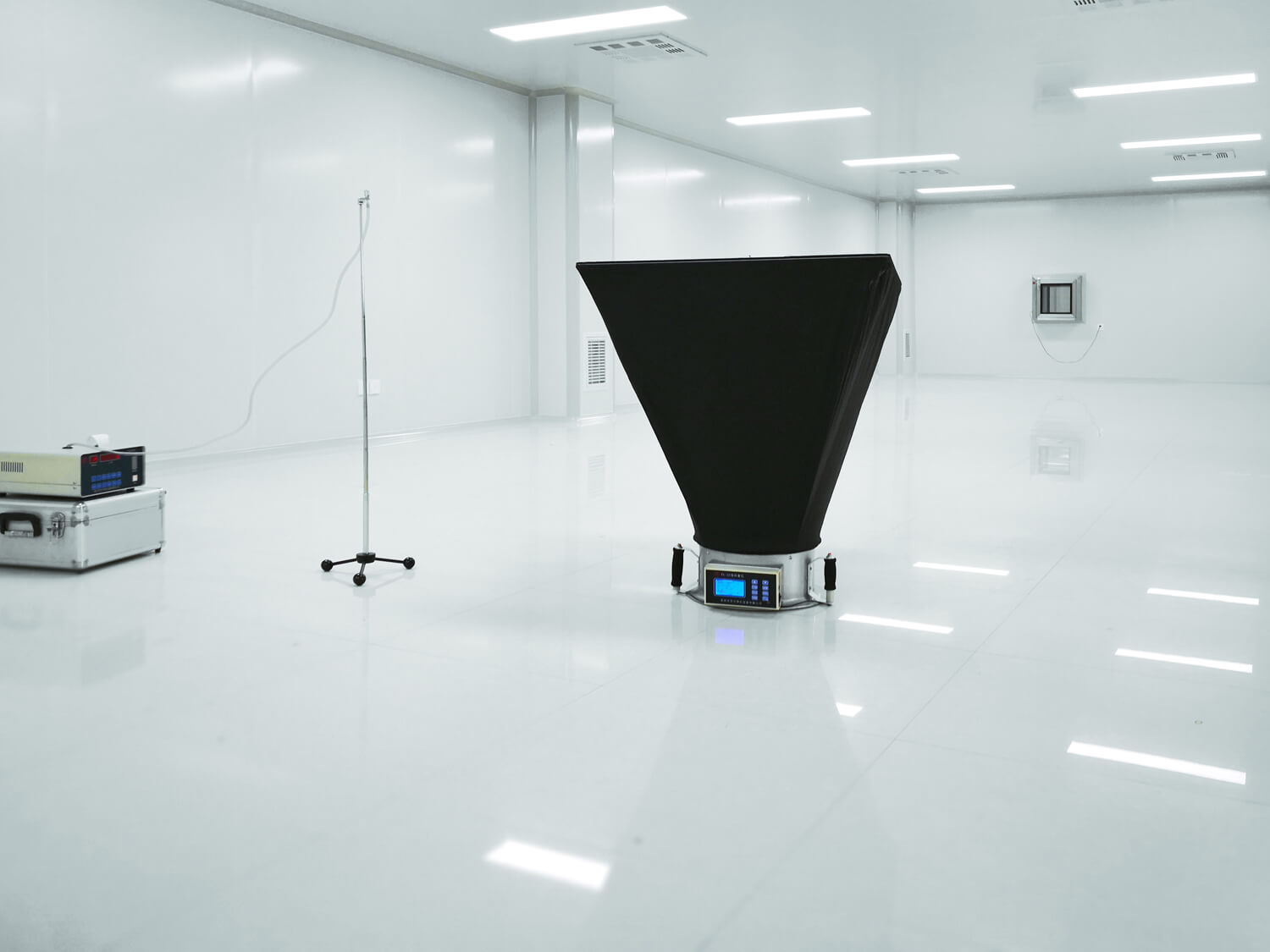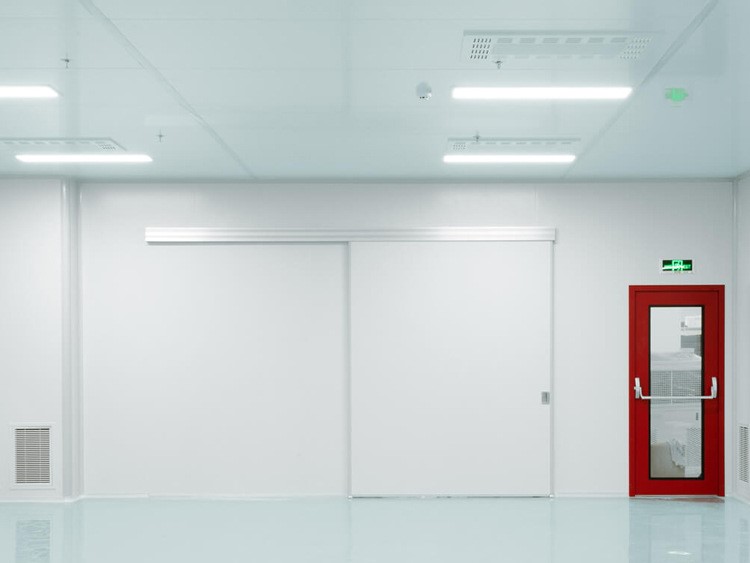

Scope of detection: clean room cleanliness assessment, engineering acceptance testing, including food, health care products, cosmetics, bottled water, milk production workshop, electronic product production workshop, hospital operating room, animal laboratory, biosafety laboratory, biological safety cabinet, ultra-clean work bench, dust free workshop, sterile workshop, etc.
Test items: air velocity and air volume, number of air changes, temperature and humidity, pressure difference, suspended particles, planktonic bacteria, sedimentation bacteria, noise, illuminance, etc.
1. Air velocity, air volume and number of air changes
The cleanliness of clean rooms and clean areas is mainly achieved by sending in a sufficient amount of clean air to displace and dilute the particulate pollutants produced in the room. For this reason, it is very necessary to measure the air supply volume, average air velocity, air supply uniformity, air flow direction and flow pattern of clean rooms or clean facilities.
Unidirectional flow mainly relies on clean air flow to push and displace the polluted air in the room and area to maintain the cleanliness of the room and area. Therefore, the air velocity and uniformity of its air supply section are important parameters that affect cleanliness. Higher, more uniform cross-sectional air velocity can remove pollutants generated by indoor processes more quickly and effectively, so they are the main testing items to focus on.
Non-unidirectional flow mainly relies on the incoming clean air to dilute and dilute the pollutants in the room and area to maintain its cleanliness. Therefore, the greater the number of air changes, the more reasonable the airflow pattern, the more significant the dilution effect, and the cleanliness will be improved accordingly. Therefore, non-single-phase flow clean rooms, clean air supply volume and corresponding air changes are the main air flow test items to focus on. To obtain repeatable readings, record the time average of the wind speed at each measuring point. Number of air changes: Calculated by dividing the total air volume of the clean room by the volume of the clean room
2. Temperature and humidity
Temperature and humidity measurement in clean rooms or clean facilities is usually divided into two levels: general testing and comprehensive testing. The first level is suitable for completion acceptance testing in an empty state, and the second level is suitable for static or dynamic comprehensive performance testing. This type of test is suitable for occasions with strict requirements on temperature and humidity performance. This test is performed after the airflow uniformity test and after the air conditioning system has been adjusted. At the time of this test, the air conditioning system was fully operational and conditions had stabilized. Set at least one humidity sensor in each humidity control area, and give the sensor sufficient stabilization time. The measurement should be suitable for the purpose of actual use, and the measurement should be started after the sensor is stable, and the measurement time should not be less than 5 minutes.
3. Pressure difference
The purpose of this test is to verify the ability to maintain a specified differential pressure between the completed facility and the surrounding environment, and between spaces within the facility. This detection applies to all 3 occupancy states. This test needs to be done on a regular basis. The pressure difference test should be carried out with all doors closed, from high pressure to low pressure, starting from the inner room farthest from the outside in terms of plan layout, and testing outward in sequence; adjacent clean rooms of different levels with interconnected holes ( area), there should be a reasonable airflow direction at the opening, etc.
4. Suspended particles
The counting concentration method is used, that is, the number of suspended particles greater than or equal to a certain particle size in a unit volume of air in a clean environment is measured by a dust particle counter to evaluate the cleanliness level of suspended particles in a clean room. After the instrument is turned on and warmed up to stability, the instrument can be calibrated according to the instructions for use. When the sampling tube is set at the sampling point for sampling, the continuous reading can only be started after the count is confirmed to be stable. The sampling tube must be clean and leakage is strictly prohibited. The length of the sampling tube should be based on the allowable length of the instrument. Unless otherwise specified, the length shall not exceed 1.5 m. The sampling port of the counter and the working position of the instrument should be at the same air pressure and temperature to avoid measurement errors. The instrument must be calibrated regularly according to the instrument's calibration cycle.
5. Planktonic bacteria
The minimum number of sampling points corresponds to the number of suspended particle sampling points. The measuring point in the work area is about 0.8-1.2m above the ground. The measuring point at the air supply outlet is about 30cm away from the air supply surface. Measuring points can be added at key equipment or key work activity ranges. Each The sampling point is generally sampled once. After all sampling is completed, place the petri dishes in a constant-temperature incubator for no less than 48 hours. Each batch of culture media should have a control experiment to check whether the culture medium is contaminated.
6. The measuring point of the sedimentation bacteria working area is about 0.8-1.2m above the ground. Place the prepared petri dish at the sampling point, open the lid of the petri dish, expose it for the specified time, then cover the petri dish, and place the culture dish The dishes should be cultured in a constant temperature incubator for no less than 48 hours. Each batch of culture medium should have a control experiment to check whether the culture medium is contaminated.
7. Noise
The measurement height is about 1.2 meters from the ground. If the area of the clean room is less than 15 square meters, only one point in the center of the room can be measured; the test points are towards the corners.
8. Illumination
The measuring point plane is about 0.8 meters away from the ground, and the points are arranged at a distance of 2 meters. The measuring points in rooms within 30 square meters are 0.5 meters away from the side walls, and the measuring points in rooms over 30 square meters are 1 meter away from the wall.
Post time: Sep-07-2023

